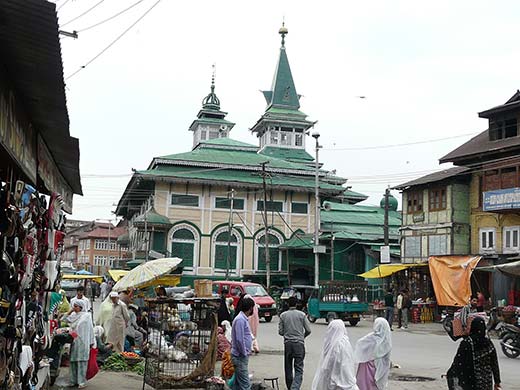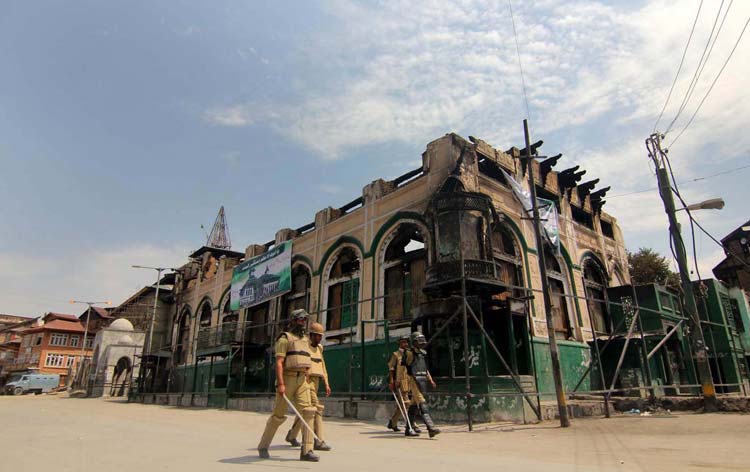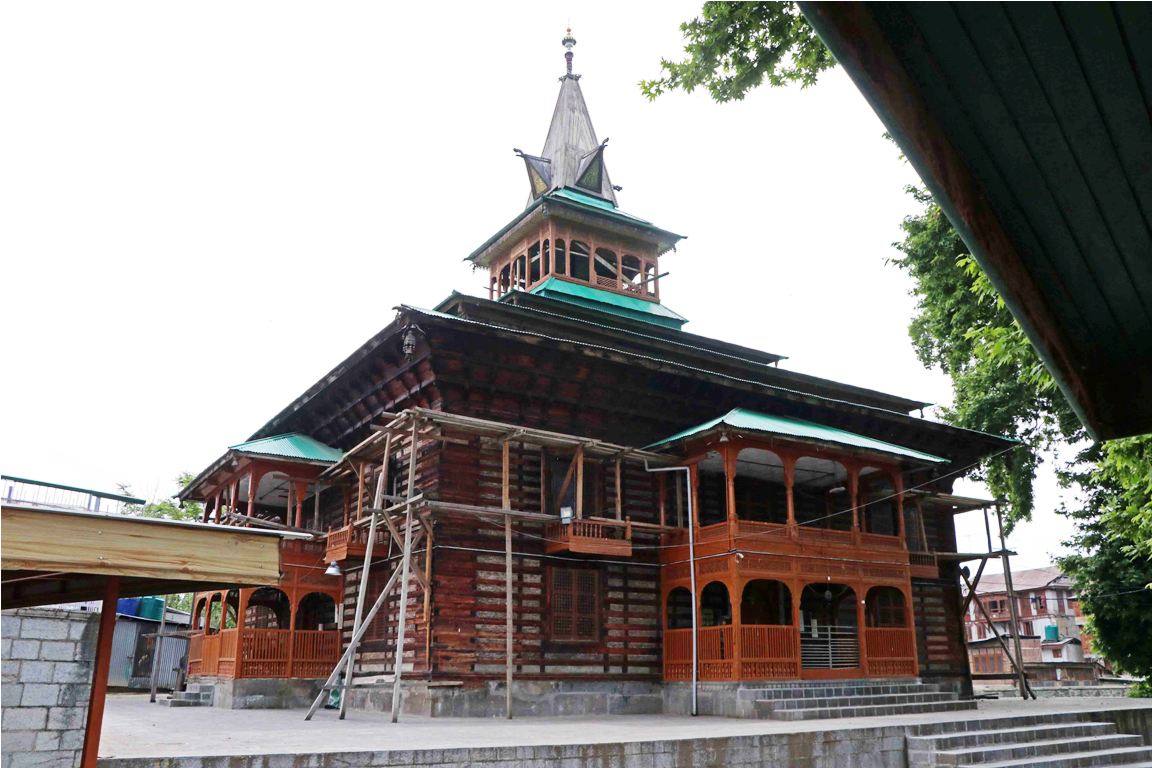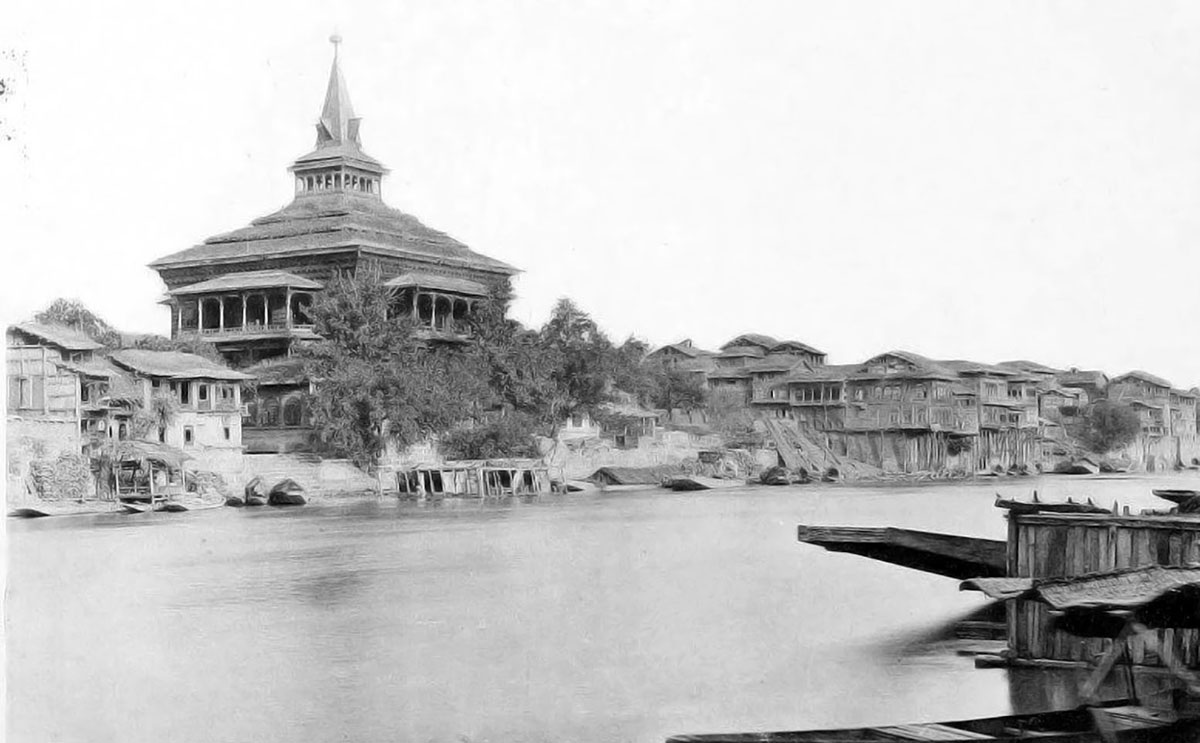In the name of preservation of historical shrines, the government is building new structures within their premises, irking experts, who say these ugly brick and mortar constructions would leave no room for open spaces. A Kashmir Life report.

Pic: Bilal Bahadur
“They sold it,” cried an old beggar while seeking alms for purchasing cigarettes outside Dastgeer Sahab shrine in old city. “Now they are selling Khanyar too.” His unprovoked anger was aimed at “depopulation” around the shrine. The government is busy negotiating deals with the residents to pave way for “beautification” of the shrine.
There is a surge across the globe to conserve the built heritage. Even various organs of the United Nations and certain trusts and NGOs are pumping millions to help societies in such endeavours. A lot of money is spent on various such projects across India. Kashmir has somehow managed to wake up and seek its pie from the huge corpus of funds meant for this purpose. Immediately, the government identified two shrines, Dastgeer Sahab in Khanyar and Naqshbandh Sahab in Khawaja Bazaar, for preservation and beautification.
The work to protect the symbols of our cultural and religious heritage started in the preceding regime. Apart from removing a couple of houses and a mosque in front of the grand old Jamia Masjid, the government removed a number of structures around Hazratbal shrine.
Though Hazratbal shrine has 250 kanals (12.5 hectares) of premises, it still was very close to a congested locality. As the Wakf Board acquired all the 81 structures located around the shrine it added 13 kanals of land to the complex. The people who were uprooted from the spot were rehabilitated at a number of places.
The shrine has been the epicentre of many political upheavals of Kashmir. When the holy relic disappeared from the shrine in December 1964, it led to the fall of Bakhshi regime. Even during the armed militancy, it remained in a state of siege for 22 days in 1992, when militants were holed up inside. The siege led to widespread disturbances across Kashmir including a massacre in Bijbehara in Islamabad district. In 1994, the government forces gunned down all the 32 activists of the Amanullah faction of the JKLF, after they purportedly received reports that the latter were tampering with the sanctum sanctorum of the shrine. A major Muslim shrine in the valley, Hazratbal, draws hundreds of thousands of devotees on certain occasions. Additions to space are a must.
During Azad government, 65 kanals (3.25 hectares) of the cherry garden were laid with turf. The shrine’s western premises spanning over 52 kanals (2.6 hectares) were also redone, allowing space for another 50,000 people to offer prayers.
The second shrine that became the priority of the government’s preservation efforts was the shrine of Syed Abdul Rehman Bulbul Shah at Bulbul Lankar. It had developed cracks and was in a dilapidated condition. The blueprint was drafted in 2005 and the work started in 2006.

Shah (died 1327 CE) was a Turkic Muslim missionary who is credited for Buddhist prince Rinchana’s conversion to Islam. The prince (whose palace premises now houses the Nawakadal women’s college) became Sultan Sader-ud-Din and later constructed a huge public dining hall called Lungar in Shah’s honour (hence Bulbullangar). The spot housed Kashmir’s first mosque, which is in ruins.
The shrine was reconstructed at a cost of Rs 1.80 crore. But it did not impress the experts who allege that it is “rebuilding not restoration”. “This (new) building is a glaring example of unsympathetic and insensitive treatment to the built heritage of Kashmir,” M Saleem Beg, former DG Tourism who now heads the state chapter of INTACH said in a letter to the tourism ministry. “There is a need to arrest such a vandalisation of the whole built fabric of the historic part of the city, unfortunately, funded and promoted by the government agencies.”
Accompanied by senior government functionaries, Beg had visited the shrine early this year. By then the two outer walls of the shrine had been demolished and replaced by new walls. “We were informed that the old building had developed structural problems. Instead of addressing these problems, they decided to demolish the structure. This has invariably been a sad but typical engineering response to such problems,” he wrote in the letter.
Beg said the structure was not very old and did not fall in the typology prevalent for shrines in Kashmir. “We have time tested system evolved over the centuries that help manage the problems which had emerged in the shrine,” he said. But that was not taken care of. “The building that is coming up in the name of the shrine looks like a house, of a nouveau rich person who wants to exhibit wealth through extravagance and, if I may say, a clumsy combination of concrete, brick and stone,” he wrote.
Jammu and Srinagar are among the 65 B-category cities eligible for funding under Jawaharlal Nehru National Urban Renewal Mission, a massive city modernisation scheme launched in December 2005. The government has set top priority to the two shrines that fall in Rural Development Minister Ali Mohammad Sagar’s Khanyar constituency.
The shrine of Dastgeer Sahab is relatively a modern structure.
Historical references suggest that an Afghan traveller visited Kashmir and presented the then governor Sardar Abdullah Khan holy relics belonging to Baghdad Sufi saint Shaikh Syed Abdul Qadir Jeelani (1077–1166 CE). There is no record suggesting the saint ever visited Kashmir. But for displaying his relics the shrine was set up in 1806 CE and was later extended in 1877.
Apart from the main Shrine, the existing premises will have a hamam and a mosque. Over the years this stone-floored and khatamband ceiling shrine has emerged as one of the best heritage places. A graceful white and green exterior complements a glorious papier-mache interior full of Arabic script and floral motifs, supported by papier-mache palms. The structure is surrounded by residential houses on three sides. Though people trickle in at the shrine regularly, it witnesses huge rush on 11 Rabi-us-Sani of the Muslim calendar.

The government has flagged its preservation plans from this shrine. The information available with the Kashmir Life suggests the tentative cost of the project is Rs 48.77 crore, of which Rs 10 crore has been released and Rs 8.45 crore already spent. State-run Projects Construction Corporation has been given an advance of seven crore and the balance Rs 1.45 crore has gone into the acquisition of the private properties surrounding the shrine.
The project envisages acquiring as many as 115 structures besides 132 shops and 20.60 kanals of land. The government would require 230 plots for the people it uproots in Khanyar. The government so far has taken over six houses and two shops beside one kanal of land.
Naqshbandh Sahab shrine at Khawaja Bazaar is also on the government’s priority list of heritage structures for preservation. Records suggest the premises, earlier known as Bagh-e-Hassain Shah, housed the palace of Sultan Hussain Shah Chak.

The king had set up a school within the premises. After Mughals invaded and took over, Emperor Shah Jehan gifted the garden to a prominent Sufi Khawaja Mahmud Naqshbandi. Soon after a Khanqah (Historically a structure built for the purpose of preaching and imparting craft skills) was constructed. Most of his family members and close followers are buried in a shrine very close to the Khanqah. In the premises is a shrine, a Khanqah, a hamam and a martyrs’ graveyard where civilians massacred by the Dogra soldiers on July 13, 1931, are buried. When the moi Mubarak (a holy relic of the prophet, now housed at Hazratbal) was brought to Srinagar it was initially kept and displayed at this shrine.
The shrine witnesses huge crowds on 3 Rabi-ul-Awal of the Muslim calendar. On July 13, every year, there are a series of political functions to pay tribute to the martyrs of 1931 CE. Martyrs Day is a state holiday. The main shrine is said to have developed some cracks forcing the government to formulate an immediate action plan.
The project cost is Rs 14.39 crore out of which Rs 10 have been released. Seven crore has gone to the JKPCC and Rs 64 lakh for acquiring private properties. The government requires acquiring 33 houses and 23 shops besides five kanals of land. It has to manage 33 plots to rehabilitate the people it would dislocate. The progress is slow as only two houses and four shops have been acquired so far.
For the Dastgeer Sahib shrine, the government is building two additional mosques – one each for males and females, both these will be connected to the main shrine, a middle rung official in the JKPCC said. “The project needs a lot of land that is yet to be acquired by the revenue department.” Right now, the PCC has taken up the construction of the mosque for males that would be two-story structure to accommodate 1000 people. It will have the facilities for ablutions as well and the project would cost Rs 6.89 crore. The other mosque will have to wait till acquisitions are done.

In Naqshbandh Sahab premises, the plans, according to JKPCC is to create an 80-ft Minar-e-Kashmir and an adjoining auditorium that will accommodate 800 people. “This is aimed at creating a facility for the functions on July 31 every year,” the officer said. But the project is on hold for want of land acquisition. “Right now, we are busy repairing and renovating the shrine on the directions of (revenue minister) Sagar sahib,” the officer added.
Beg is furious.
“They (government) do not understand the sanctity of space,” he said, “Globally the idea is to add open space without adding to the constructions or recreating the shrines in the name of preservation.” The idea should have been to create vast swathes of green space around these monuments so that they feel distinct and majestic. But they are distorting it, he asserted.
Though Beg says he is not aware of the actual drawings of the projects, he is not happy with what is being done on the ground. “If what I heard is true then they are creating another structure that will dominate the main shrine of Dastgeer Sahab,” he said. “If that happens the actual shrine will look like the servant quarter of the new building that the government intends to build.”
In Naqshbandh Sahab as well, Beg says, they have plans of creating Shaheed Minar, a tower in memory of the martyrs of 1931. “They must know that such kind of constructions will visually be dwarfing the status of the main shrines,” he added. Critics allege that the main factor behind the plans of creating new structures is to book expenditure because it pays.















